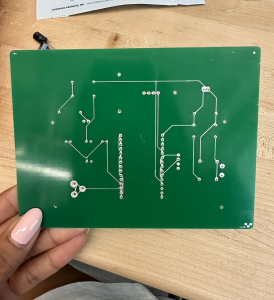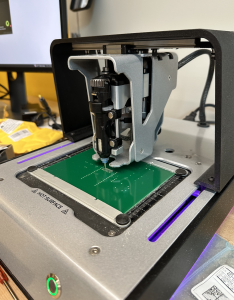This week we spent the majority of our time on the PCB design and fabrication. Earlier in the week, we made the decision to order MQ-02 smoke sensors that came with a breakout board. This is because originally, we thought that because we figured out how to read from the sensors we wouldn’t need the additional breakout board and thus, could directly attach the sensor by itself to our PCB. However, upon more research from last week we realized that if we wanted to control the sensitivity of the smoke sensor, we would need a potentiometer. There are smoke sensors that come with breakout boards with a potentiometer for this reason, and if we just had the smoke sensor on its own then we would have to build a new circuit which included a combination or more resistors, diodes, op amps, and transistors which we realized a) we would be making up the internals of the breakout board and b) it wouldn’t make sense do do seven times for each PCB that we were fabricated. Based on this, we placed a new order of smoke sensors which should be arriving Monday and we already know how to set it up which is great.
After our weekly meeting with Professor Mukherjee and Kaashvi, we found out the Quinn, the lab technician, was learning how to use the Voltera machine in Techspark that allows us to make the PCBs from scratch. Immediately after this conversation, we reached out to him and he let us send over an initial PCB design that he got started on. On Thursday, we found that some of the holes in our design were too close together resulting in the conductive ink joining pads that otherwise shouldn’t have been connected. Aidan worked to quickly fix these issues and we sent over another design. On Friday, I met with Quinn to learn how to use the Voltera and he walked me through the process using our new design. While the front of the board printed well, there were multiple issues on the back regarding the conductive ink flow. It was not being calibrated properly and a lot of the traces ended up being too thick and the conductive ink would get dragged across the board forming connections that we shouldn’t have on our board. While we didn’t have the right drill bits for some of our bigger holes, Quinn promptly ordered them and I will be going back in on Monday when they arrive to finish the PCB we made and clean up the incorrect connections. While this was a time consuming process, we greatly appreciate the effort Quinn spent with us and we hope that we can make a PCB using this machine sometime next week. There are just a lot of steps that can go wrong, the biggest being the act of controlling the flow of the conductive ink so that it is precise. While it would be difficult and time consuming to do all 7 PCBs in this manner, Quinn helped us place an order through JLCPCB with our updated PCB design which should hopefully come in next week. I have attached pictures of the Voltera at work below.


In an attempt to see if we can find another way to make our PCBs in Techspark, Aidan and I tried to learn how to use the Bantam milling machines as shown below. However the material we had was copper with the middle non-conductive layer so essentially the mill would etch away and leave the copper in the places where the traces lie. We experimented with this for a while after downloading the corresponding software and attaching our Gerber files but we couldn’t find a way to ensure the machine would etch the excess copper away instead of tracing out the exact circuit.

We have also started working on the slides to prepare for the final presentation next week. This weekend and in the upcoming week, we plan to work on the slides and incorporate components that we have gotten working from the interim demo and beyond. When the smoke sensors come in, early next week, I hope to quickly test them and find a working threshold for fire detection. When the PCBs come in next week, Aidan and I plan to test each sub circuit and confirm that our PCB works as intended or quickly make changes as necessary. With regards to the Gantt chart, I am feeling a bit more pressed for time despite actually being on schedule given that we already sent the PCBs for fabrication and next week will be all about assembling the board and testing its correctness but we will have to act quickly if things don’t go as expected.
